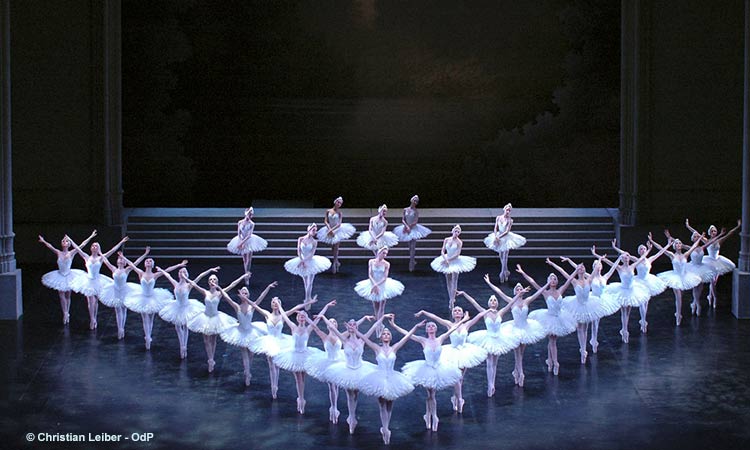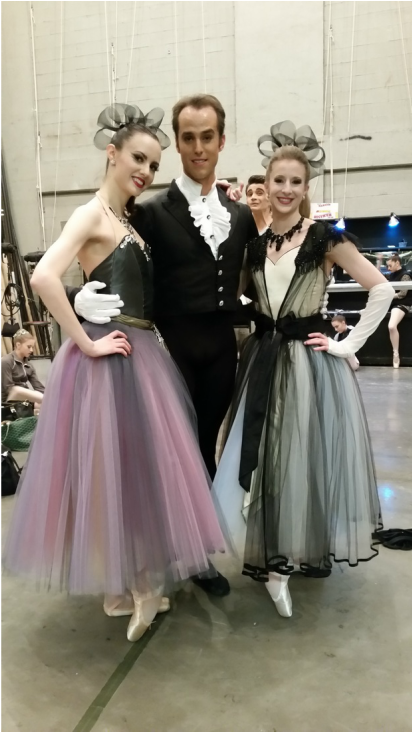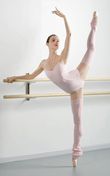Nureyev’s Swan Lake was in some ways familiar. It is, like the Peter Martins version that we dance at NYCB, fashioned after the original 1895 production by Marius Petipa and Lev Ivanov, so many of the steps were very similar to ours. A few portions of the choreography were fairly standard: the Act I pas de trois, and some of the divertissements in Act III. Yet this production, like many of Nureyev’s works, had a much richer role for the male lead than usual. I think Prince Siegfried had more solos than the Swan Queen! Nureyev had choreographed the ballet for himself (and Margot Fonteyn) back in 1964 and had the Paris Opera adopt it twenty years later when he became artistic director of the company. In Diane Solway’s biography of Nureyev, he candidly explains why he fleshed out the prince’s role: “[h]e sits on his ass for 35 minutes and then suddenly has to walk. Impossible.” He’s right. Typically, the prince is a bit of a blank and sits like a prop through most of Act I. He normally doesn’t begin his dancing until Act II, when Odette the Swan Queen first appears. In the Nureyev version, Odette also has an earlier entrance. She appears briefly in human form in a prologue in which she is kidnapped and spirited away by Rothbart on swan wings.
In Nureyev’s treatment, it is almost as if Siegfried and the evil sorcerer Rothbart have the deepest psychological connection, and indeed they may represent a mind divided. They even have a long, violent pas de deux together before Siegfried goes swan hunting in Act I. The Rothbart role is expanded here, and it is very much a dancing one. He has a technical solo in the ballroom scene in Act III and is a full partner in the Black Swan pas de deux—er, trois, I guess is more apt here. Nureyev was playing with Freudian id, ego, and super-ego concepts which make a lot of sense in the context of the story: Odette/Odile is a dual role so Siegfried and Rothbart may as well be psychological foils too. Although, so many fractured psyches threaten to make the plot hopelessly schizophrenic.
But even the traditional Swan Lake tale is none too rational. I have never understood, for example, why the prince is so easily deluded when the swan whom he believes is his lakeside love Odette (but who is really her evil twin, Odile) enters the Act III ballroom in new plumage and the completely opposite relationship with her captor from the close of the previous act. At their Act II parting, the virginal and reticent Odette tells Siegfried that only his true love can save her from her evil tormenter. But when “she” next appears with a coldly seductive attitude and Rothbart as her best friend, Siegfried buys it whole hog.
It is established early on in the ballet that the prince is a wistful daydreamer. But he knows that Rothbart is a sorcerer with bad intentions and freakish control issues; he should at least be a tad suspicious that the black swan in Act III could be a blatant trap—an evil duck decoy. To so quickly conflate the two women—Odette and Odile—exposes some terribly flawed logic on the prince’s part. What does he think? “Sweet, Rothbart and my swan girlfriend have made up and she is allowed to marry me without a problem and wow is she horny in this new black feather getup!” Perhaps Odette’s condemnation to an eternity of swandom is not so grave after all. Methinks Siegfried may not have proven to be a faithful husband (or a very intelligent companion) in the long run.
Actually, Nureyev’s conceit fixes this problem somewhat. Because Rothbart is involved with Siegfried from the beginning of the story as an intense mentor (lover?) figure, it makes a little more sense that Siegfried could be confused and taken by this man he has known for so long in so many mysterious guises. But Swan Lake is always better read as a series of metaphors: for the ideal woman, for the quest for meaning, for rebellion (the prince seeks life beyond a conventional marriage and societal expectations), for good and evil, for the damnable difference between action versus intent.
The dancers I saw in the lead roles were excellent. Héloîse Bourdon, a young sujet making a big debut, was Odette/Odile. She is surely poised for great things. The more experienced Josua Hoffalt, an étoile with long lean lines, was her Prince. And Florimond Lorieux, another sujet, was a dramatic and captivating Rothbart despite the challenges foisted upon him by the costume department. He battled with his onerous cape while trying to partner throughout the Black Swan pas, and when he removed it for his solo a sparkly black and green skintight suit was revealed that reminded me a lot of the Will Ferrell film Blades of Glory. Other than that, the costumes were done in sumptuous velvets and brocades and were very beautiful. The pastel palette of the Act I and III court scenes surprised me. I usually associate lilacs and pinks with Sleeping Beauty and darker hues with Swan Lake, but it was very pretty nonetheless. Another dancer who really stood out to me was Hannah O’Neill in the first act pas de trois.
As for the Nureyev choreography, I wasn’t a big fan of the Act I crowd dances which were a little clunky and relied too much on canon. The dance for the four little swans was not as intricate as it can sometimes be, so that was also a bit sleepy. But the swan corps was great. Aside from the four little swans number, the swan choreography was the most unusual and a lot of it was very cool. There was also a dance for four big swans which I liked very much. Best of all, the swans repeated a droopy motif in the mournful Act IV in which they bent over with one arm extended along their faces to the front as they did slow pas de chevals with their feet—rather like how little kids imitate elephants walking. It reminded me of the Salvador Dalí painting Cygnes reflétant des Éléphants which was neat since Nureyev’s production was so much about psychological doubling.
Musically, the production was very interesting. Siegfried had two solos to music I’d never heard before. Alas, some of my favorite music—the sighing violin score for the Russian divertissement—was cut. The Act III pas de quatre was also cut in this version but I didn’t miss it; I tend to find that it makes the ballroom scene drag on. The ending of the ballet was different from other versions I’d seen. In some productions the Prince and Odette end happily and break Rothbart’s spell with their true love against the odds (and the heretofore agreed-upon rules of Rothbart’s curse, hmm). Sometimes they commit suicide together by jumping into the lake (I guess they can’t swim? But she’s a swan…as I said, some plot issues). In our version the prince is left heartbroken as Odette is enveloped by her swan posse, trapped forever in avian form. I think it is a beautiful scene. In the Nureyev treatment the prologue was essentially repeated and Odette was whisked into the air by Rothbart and carried away as Siegfried died. I liked that in this production the beginning turned out to be a foreshadowing of the ending. There is something so inevitable about Swan Lake in the ballet world that it seemed appropriately circular—an eternal loop of princes and sorcerers and swans and their multiple dysfunctional selves.
It was such a treat to see the amazing Paris Opera dancers perform—ahem, rehearse. A big thank you to my friends Janie, Sébastien, and Ben for letting me have a sneak peek!



 RSS Feed
RSS Feed